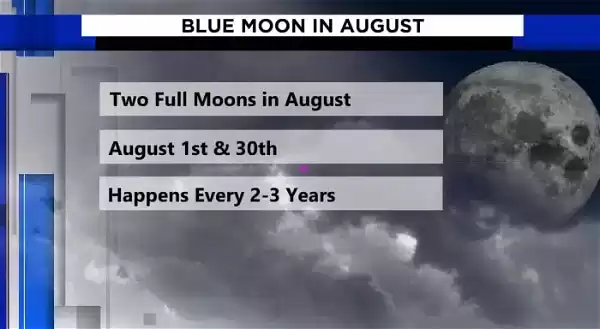"Blue Moons: Rare Astronomical Events and the Types You Need to Know"
"Rare Blue Moons to Grace the Skies in August 2023, Including a Supermoon - Don't Miss Out!"
In the realm of astronomical marvels, Blue Moons stand out as rare and captivating events. These extraordinary occurrences, as reported by ClickOrlando, have two distinct types: seasonal and monthly. It is crucial to note that the term "Blue Moon" does not imply that the moon will actually appear blue in color. Instead, it refers to a unique phenomenon that takes place once in a blue moon.
Let us delve into the intricacies of these celestial wonders. According to NASA, a seasonal Blue Moon refers to the third full moon within a season that contains four full moons. Conversely, a monthly Blue Moon signifies the second full moon to grace a single calendar month. These enchanting lunar events manifest themselves approximately once every three years on average, leaving us in awe of the cosmic dance unfolding above.
To comprehend the occurrence of Blue Moons, it is essential to understand the lunar cycle. The moon traverses through its phases in approximately 29.5 days, completing 12 lunar cycles in just 354 days. This leaves a gap of roughly 11 days, resulting in a 13th full moon appearing within a calendar year every 2 to 3 years.
In the year 2022, humanity did not bear witness to any Blue Moons. The most recent Blue Moon graced our skies on August 22, 2021. However, the year 2023 promises to bring us two full moons in the month of August. The first full moon, known as the Sturgeon Moon, will illuminate the heavens on August 1. This celestial spectacle draws its name from the giant sturgeon inhabiting the Great Lakes and Lake Champlain. Historically, this time of summer presented the most favorable conditions for catching these colossal creatures, as documented by the Old Farmer's Almanac. Although this full moon will reach its peak illumination at 2:32 p.m. ET on Tuesday, it will remain hidden below the horizon in the United States. As the evening descends and darkness envelops the sky, the Sturgeon Moon will emerge, resplendent in its fullness, in the southeast sky after sunset.
The second full moon of August 2023, which holds the distinction of being a Blue Moon, will grace our presence on Wednesday, August 30, at 9:39 p.m. ET. This Blue Moon brings an additional delight as it coincides with being a supermoon. A supermoon occurs when the Moon's orbit brings it closest to Earth, a point known as perigee, while simultaneously being in its full phase. The convergence of these two phenomena creates a breathtaking spectacle, captivating the hearts and minds of all who gaze upon it.
It is important to reiterate that the term "Blue Moon" does not imply a change in the moon's color. Instead, it serves as a metaphorical expression denoting a rare and extraordinary event. Astronomically speaking, Blue Moons are infrequent and hold a special place in our collective consciousness.
For those who may miss the opportunity to witness the Blue Moons in August 2023, fear not, for the next Blue Moon of the calendar month will grace our skies on August 30-31, 2024. Mark your calendars and ensure that you do not miss the chance to marvel at these celestial wonders. The moon, with its ethereal beauty, never fails to captivate our senses and inspire a profound sense of wonder.











Comments on "Blue Moons: Rare Astronomical Events and the Types You Need to Know"